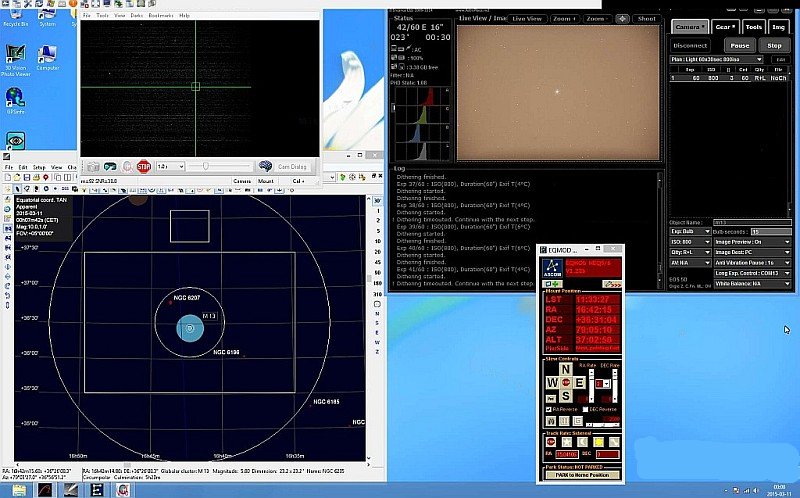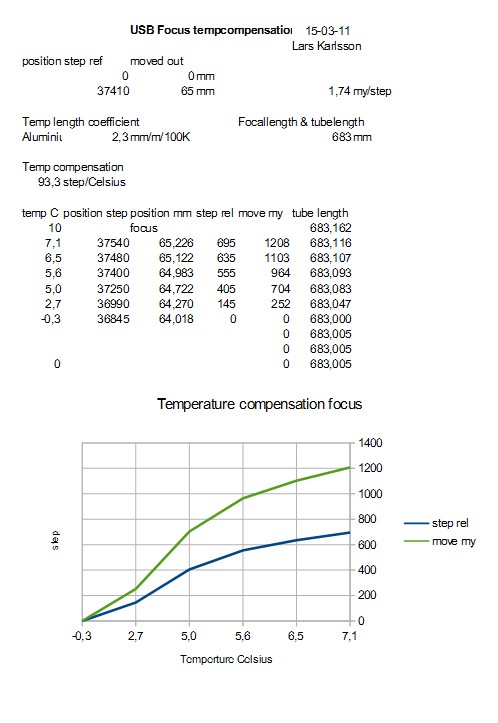|
Advertisement / Annons: |
My astronomy project:
|
Content:
Note: |
4: Focus and temperature compensation 1Now, finally when the focus project has come so far that I can start looking at the temperature compensation. Yesterday, when it was a clear night, I photographed M13, got the focus pretty good, but also noticed when it became sharply how sensitive it is to temperature variations. Already one degree Celsius change focus and the focus is not good anymore. My pixel scale is very rough, 2.5" per pixel. Good for capture many photons quickly. But the resolution of the telescope are not used at good seeing nights, although Drizzle function can be used when stacking to increase the resolution. This is yet another strong argument for a Sony mirror less cameras that I have written about in forums. Imagine a Sony A7R II, then you have both large field and high-resolution, well enough for this relatively small telescope. You lose FW, Full Well capacity with small pixels but if read noise is low, it is not as serious problem. Also sensitivity will be lower with small pixels.
Update: Seeing puts the limit to the maximum resolution so already this telescope of 130 mm resolving power is difficult to use. I have never earlier managed to get better focus than 5" to 15" in FWHM from my balcony, now with stepper motor focus I got some stars inside one pixel, FWHM about 2 pixel or 5" or less. The image on the M13 is stacked with Drizzled function, or moving colors, which is a variant of Drizzle. So basically consists picture of 3 * 12 Mpix = 36 Mpix data before cropping. A DSLR image are usually interpolated in the deBayer process and thus get lower resolution than necessary. 
Here are the astro server running and shooting M13. The control of focus handle by APT and the ASCOM driver that came with the USB-Focus. Unfortunately it is not directly temperature compensating in this setup. Maybe APT will have it updated in the future. I will write to the developer Ivo of APT and ask (Update 2017: There is temperature compensation built in ATP now). Now it is one thing that puzzles me. If the temperature falls, then it shrinks the metal tube of the telescope. Example. aluminum, 2.3 mm for each 100 degrees Kelvin per meter. Then it should be reasonably to set the focuser outwards when temperature falls to compensate so it have the same distance to the sensor and keep the focus, in this case 683 mm. See the table below how surprising behavior it has: 
According to this I will do the opposite when it gets colder, then the tube is 0.12 mm shorter and I will focus inwards direction 1.2 mm, it is a factor of 10 over the length of the expansion (shrinkage) and with the wrong sign. Possibly I make an error of thought now when it's 4 am in the morning.
Update: It's in German language so you have to translate it maybe, use Google translator or similar. Thanks a lot Bernd for this information! With the USB-Focus it's delivered a program that can handle the focus and temperature compensation, was not able to get it started yesterday and I did not want to cancel the exposure series I started, have to take it at the next opportunity.
|
|